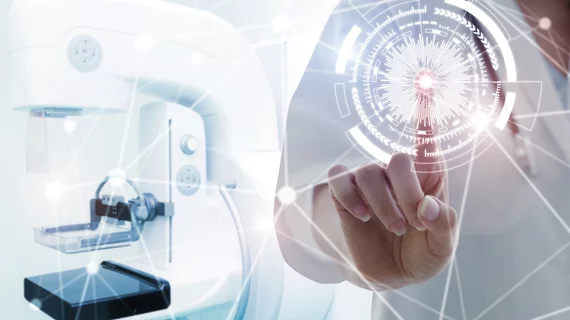DBT-based radiomics nomogram predicts lymphovascular invasion in breast cancer patients
In patients with invasive breast cancer, DBT-based radiomics could play a valuable role in predicting lymphovascular invasion.
Researchers developed and tested a radiomics nomogram on 135 women with invasive breast cancer (IBC) who underwent preoperative digital breast tomosynthesis. The DBT-based combined radiomic nomogram achieved a specificity of nearly 95% when predicting lymphovascular invasion, which was higher than other clinical predictive models.
“Lymphovascular invasion (LVI) is a precursor step in the infiltration-metastasis cascade process of breast cancer, and multiple studies have demonstrated that LVI is significantly associated with poor prognosis, including lethal distant metastases,” corresponding author Lirong Zhang, PhD, from the Department of Medical Imaging at the Affiliated Hospital of Jiangsu University in China, and co-authors explained. “A practical way to assess LVI status non-invasively and accurately based on preoperative imaging with enhanced confidence needs to be further explored.”
Currently, LVI is determined based on postoperative pathology, which, the experts suggested, inhibits clinicians’ abilities to preoperatively tailor treatment options. Radiomics offers detailed, quantitative information on tumor heterogeneity, enabling clinicians to preoperatively and noninvasively assess characteristics that might be predictive of LVI. Having such details ahead of time would allow providers to come up with a treatment strategy before surgery, rather than waiting. Radiomics combined with DBT imaging, which offers radiologists additional lesion details, could provide invaluable information preoperatively and help guide treatment decisions even more precisely.
For the study, experts divided 135 patients with pathologically confirmed IBC into training and validation sets to train the DBT-based combined radiomic nomogram. The signature was constructed using 9 out of 1,218 extracted imaging features.
Out of 135 patients, 60.2% and 59.5% in the training and validation sets were LVI-positive. Independent risk factors for LVI were higher Rad-score, maximum tumor diameter and spiculate margin. The radiomics nomogram achieved a sensitivity and specificity of 72.7% and 94.6% in the training set, and 80.0% and 76.5% in the validation set. These numbers were higher than models incorporating clinicoradiological semantic features alone or the radiomics signature alone for both datasets.
“Preliminary results indicated that the DBT-based radiomics features were strongly associated with LVI,” the experts wrote. “The proposed combined radiomics nomogram, incorporating Rad-score and clinicradiological risk factors, yielded satisfactory evaluative performance for LVI status. It would be a valuable reference for subsequent radiomics studies.”
The detailed research can be viewed in Academic Radiology.
More on digital breast tomosynthesis:
Less experienced radiologists are more susceptible to fatigue when reading DBT exams
DBT spot compression views increase reader accuracy
New data on false positive rates for DBT and DM screenings
Digital breast tomosynthesis outperforms DM at detecting malignancy in developing asymmetries

